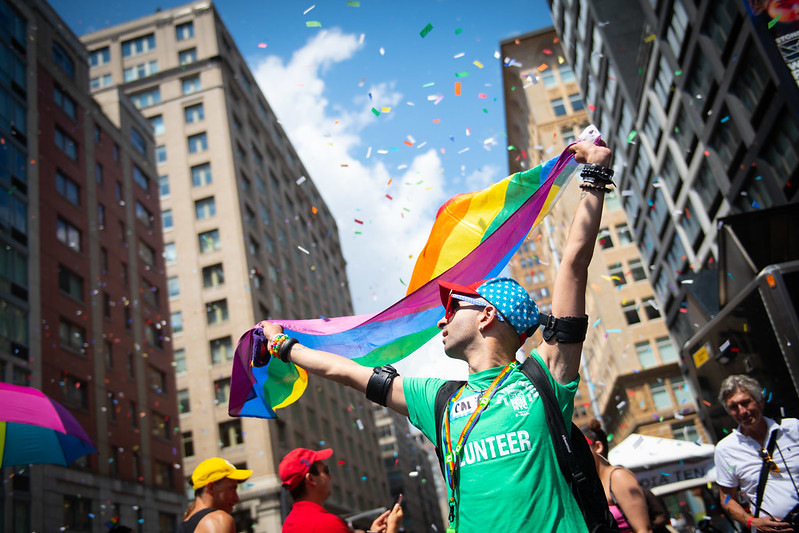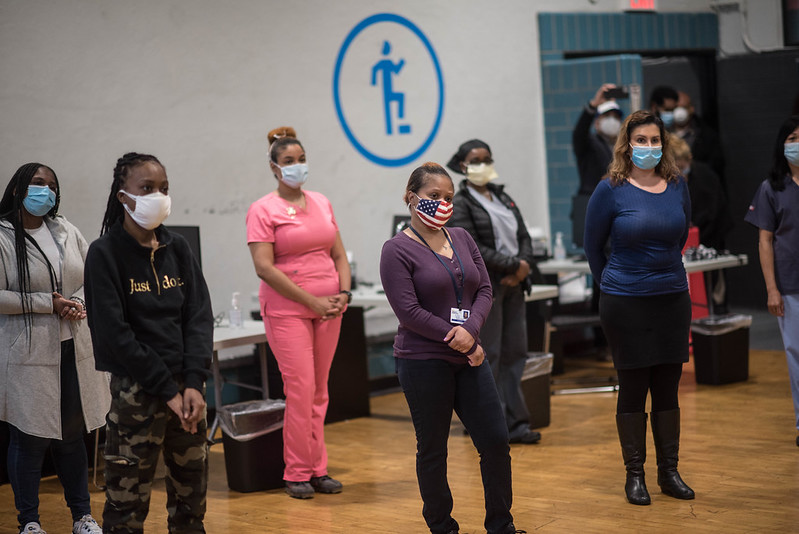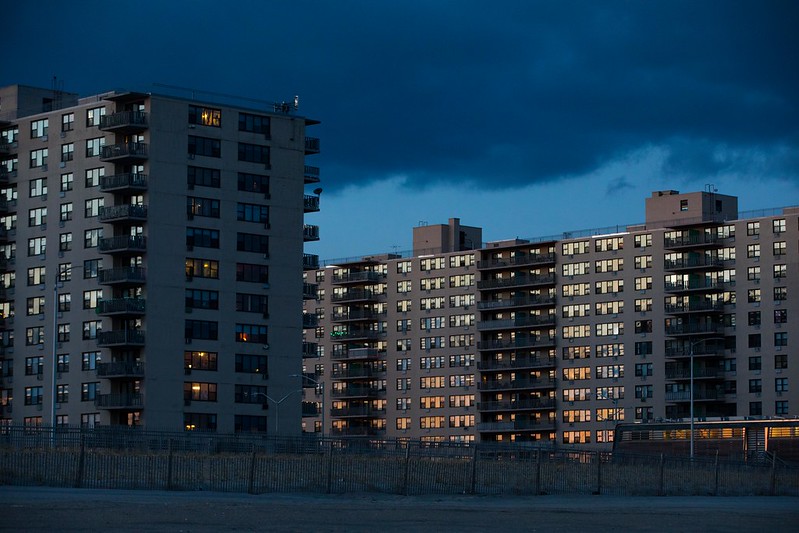Pride and Ending the HIV Epidemic in New York This Year

June is Pride month (photo: Michael Appleton/Mayoral Photography Office)
Octavia Leona Kohner is a former sex worker and a survivor of sexual assault. As a woman of transgender experience, she’s 49 times more likely than the general population to be HIV positive. But Octavia is HIV negative. She’s an example of the tremendous progress we’ve made in our effort to end the HIV/AIDS epidemic in New York State -- an epidemic that has disproportionately impacted the LGBTQ community and communities of color.
Six years ago, New York set out to end HIV by 2020, and thanks to Governor Cuomo’s leadership, we are on the verge of becoming the first state in the country to do so, 10 years before the national goal of ending the epidemic by 2030. The most recent data from the New York City Department of Health and Mental Hygiene shows that in the first half of 2019, 876 New Yorkers were newly diagnosed with HIV, down from 984 for the same time period the previous year. That’s progress we can be proud of, and Pride month is a time to celebrate our successes. But there is still more work to do.
As with COVID-19, communities of color are the hardest hit by HIV. Institutional racism and social, economic, and educational inequities lead to stark health disparities. In the first half of 2019, Black (45.8%) and Latino (37.4%) people still represent a disproportionate share of new diagnoses in New York City. And transgender people were one of the only groups to see a slight increase in new HIV diagnoses in New York City from 2017 to 2018. Most new diagnoses come from zip codes with above average levels of poverty.
The HIV and COVID-19 crises reaffirm the vital importance of fighting for health-care access, racial justice, and health equity. For example, pre-exposure prophylaxis (PrEP) is a medication that is 99% effective in preventing HIV transmission, yet it isn’t reaching many who need it most. Medicaid Special Needs Health Plans are specifically designed to provide care to people who live with or are placed at elevated risk for HIV. Octavia is a member of Amida Care, New York’s largest Special Needs Health Plan, which connects HIV-negative members like Octavia to PrEP.
When Octavia started on PrEP, she spoke with an Amida Care pharmacist who helped dispel misinformation about the treatment and answer her questions. Some trans people fear that PrEP may interfere with or interact poorly with their hormone therapy, so having a trusted, readily available resource for accurate information is critical. Amida Care’s pharmacy team follows up regularly with Octavia to make sure she’s adhering to her treatment and responding well. She has also accessed mental health services through Amida Care.
Amida Care works closely with members to create personalized care plans based on each individual’s unique needs, connect them with culturally competent providers, and support them to stay in care and take their medications. Amida Care’s Live Your Life wellness program gives members access to free events to feel good in their own body.
Thanks to medical advancements, HIV can now be treated with just one pill a day, but many people living with HIV today are taking additional medication to manage other chronic conditions including hypertension, diabetes, depression, and addiction. Special Needs Health Plans like Amida Care provide wraparound care to ensure members get the medications they are prescribed and adhere to their personalized care plan. Amida Care also checks that there are no adverse side effects or potentially bad interactions of multiple prescribed medications, and helps to streamline administrative processes for providers.
Pharmacy care management is critical to improving health outcomes, avoiding costly hospitalizations and reducing the number of new HIV diagnoses. As a result, many people living with HIV have become healthier and virally suppressed, which means they are unable to sexually transmit HIV to others. The viral load suppression rate among Amida Care members in 2005 was 60% -- today it’s 80%.
Octavia has not only remained HIV negative, but she works to encourage others to consider PrEP and take control of their sexual health. She’s found a community that supports her in living her most authentic life, and she works to support others as a gender and sexuality consultant.
We have made great progress toward reaching our goal of ending the HIV epidemic in New York. Special Needs Health Plans will continue to do our part - through the end of 2020 and beyond - by working in the hardest hit communities and improving health outcomes for all.
***
Doug Wirth is the President and CEO of Amida Care. On Twitter @AmidaCareNY.
***
Have an op-ed idea or submission for Gotham Gazette? Email This email address is being protected from spambots. You need JavaScript enabled to view it.
Ensuring the COVID-19 Response Prioritizes the Needs of Vulnerable New Yorkers

Front-line workers (photo: Michael Appleton/Mayoral Photography Office)
The COVID-19 crisis has laid bare the fragility of our region. It has compromised our physical and mental health, caused unprecedented disruption to our economy, and created a deep uncertainty about our future.
Across the state, the pandemic has revealed how inequitably our communities are prepared to cope with an emergency of this magnitude. The Department of Health in New York City released data reflecting an alarming nationwide trend: vulnerable groups such as low-income individuals, senior citizens, and people of color are suffering from COVID-19 at disproportionate rates.
This is due not only to unequal access to health care, but also to an intersecting web of social disadvantages that form the most pervasive preconditions for any disease. Food insecurity, poverty, and housing instability are felt most acutely in the communities where the COVID-19 outbreak has struck the hardest.
As we consider the long road to recovery from this crisis, one thing is certain: we have an obligation to close the health-care gap in our state and create the conditions for a system that works better for all New Yorkers.
Preventing this kind of pandemic in the future will require a response beyond a vaccine. We must make holistic investments to address the full spectrum of health care and health-related requirements facing our most vulnerable.
What can be done?
The good news is that this crisis has revealed our capacity to help those in need.
Hundreds of organizations across our state are dedicated to serving the diverse, health, and health-related essentials of vulnerable New Yorkers. These health-care providers, nonprofits, and community groups represent a broad coalition addressing the full scope of the need throughout our state. They require our support now more than ever.
As New York's largest health-care foundation, we at the Mother Cabrini Health Foundation are in a unique position to provide ongoing support to community-based initiatives that keep people safe and fed, help them return to work, and support healthy lifestyles.
On March 31, 131 years to the day Mother Frances Xavier Cabrini arrived in New York City and rolled up her sleeves to care for the poorest New Yorkers, we announced $50 million in emergency grants to address the many health-related needs of New Yorkers as a result of the COVID-19 pandemic.
In early May we issued our first round of emergency funding, nearly half of the $50 million allocation. We supported programs and workers at more than 100 organizations who, like our namesake, have rolled up their sleeves to provide immediate, essential services: personal protective equipment for health-care and social-service workers, emergency supplies at food banks and pantries, and hazard and/or overtime pay to frontline, direct-service health-care workers.
These organizations include the Food Bank of Central New York, Home Care Association of New York State, Catholic Charities Brooklyn Queens, JASA, Citymeals on Wheels, Iroquois Healthcare Association Inc., Circulo de la Hispanidad, Mental Health Associates of Franklin County, and the Greater New York Hospital Foundation.
Their efforts are saving lives.
As we begin the long recovery from COVID-19, we can also help save lives by supporting policies and programs across New York State that address the broader factors that exacerbated this public health crisis, especially among lower-income communities, communities of color, and elderly populations.
Looking to our soon-to-be-announced second round of emergency funding, the Mother Cabrini Health Foundation knows that health care is the sum of many factors. Our mandate has never been more urgent.
Moments of crisis don’t only beget immediate danger; they also offer long-term opportunity.
Ours now is to take decisive action to create a more equitable healthcare landscape. We must ensure that the most vulnerable and fragile among us aren’t forced to bear the brunt of the next crisis, and that all New Yorkers can enjoy healthier, more prosperous lives.
A small nun, Mother Cabrini left a large legacy. She and her sisters addressed immediate needs by standing in the backs of churches to hand out food, clothing, and supplies to families living in poverty. Beyond this, she had an expansive vision that included the founding of schools and orphanages to prepare the vulnerable to survive in a system that would not always catch them were they to fall.
We honor Mother Cabrini's legacy when we put into practice what she has taught by supporting both immediate and broader health needs through nutrition, housing, education, and employment programs that will outlive this deadly virus for generations to come.
***
Msgr. Gregory Mustaciuolo is Chief Executive Officer of the Mother Cabrini Health Foundation, a private, nonprofit organization based in New York City and supporting programs throughout New York State. On Twitter @cabrinihealthNY.
***
Have an op-ed idea or submission for Gotham Gazette? Email This email address is being protected from spambots. You need JavaScript enabled to view it.
Staving Off an Eviction Nightmare by Expanding New Yorkers' Right to Counsel

An eviction nightmare looms as housing court reopens (Benjamin Kanter/Mayoral Photo Office)
A new threat is looming for the very Black and brown communities in New York City that have been hit the hardest by the dual pandemics of coronavirus and racism in policy: a massive wave of evictions.
That’s because phase 1 of New York “reopening” didn’t just apply to construction and curbside retail. It also applied to housing courts. This could have disastrous consequences for tenants. Housing court personnel have already started reporting back to their workplaces. This Monday the courts are scheduled to begin hearing eviction proceedings again. We join tenants rights activists in urgently calling for this date to be pushed back.
We also need to act now to prevent an avalanche of evictions no matter when housing court cases resume. We can do that by smartly leveraging the landmark law that established right to counsel in New York City.
Eviction cases that were suspended before the pandemic will be resumed, and there likely will be an onslaught of new cases -- the gubernatorial order pushing back evictions to August 20 does little to stop landlords from filing for new evictions.
The reopening of housing courts will also create a massive public health problem. New York City’s housing courts on a normal day are incredibly overcrowded, with tenants, lawyers, and staff crammed into hallways, waiting areas, and small courtrooms. Pre-covid, there were 2,000 people in the Bronx housing court alone, every day. Anything like a normal docket of cases will make it impossible to keep safe social distancing -- and we know that coronavirus spreads most easily in crowded, indoor settings.
There is a simple way to prevent both the massive wave of evictions and unsafe conditions in housing courts: only allow eviction cases to proceed if tenants have access to a lawyer.
In 2017 New York City enacted a landmark, first-in-the-nation law establishing right to counsel for low-income tenants facing eviction. The law is being phased in zip code-by-zip code over five years, but has already dramatically increased the portion of tenants citywide with representation, from less than 5% to now approximately 30%. It’s proven to be spectacularly successful: 84% of tenants receiving legal representation have been able to remain in their homes. No surprise that cities around the nation are enacting policies based on New York City’s example.
Now we need to head off the looming eviction crisis by immediately taking right to counsel citywide -- to every zip code. We are drafting legislation now to put this into effect immediately.
Recognizing that we are in a financial crisis, this could be done in a revenue neutral way, by simply altering existing contracts with legal providers to spread their attorneys out over all zip codes.
New York City’s housing courts have routinely adjourned cases so tenants can secure representation. In fact, after right to counsel was implemented, a Bronx judge even cancelled a judgment against a tenant because they weren’t provided a lawyer.
So if tenants in all zip codes have a right to counsel, this will slow the daily volume of cases that can move forward in accordance with the number of right to counsel attorneys available -- in practice significantly slowing the pace of evictions.
The substantial reduction in the number of people in courts will also be a win for public health, since it will make room to implement social distancing policies that otherwise would be impossible.
Over the longer-term we need to expand the scope of New York City’s right to counsel law, including through legislation we have sponsored that would raise the income cutoff. This will be critical to achieving a fair recovery for our city in the years ahead.
But right now we need to take action fast to head off a crisis that would inflict additional pain on the low-income New Yorkers who have already suffered so much during the pandemic.
Right to counsel for tenants has already proven to bring more justice to housing court. Now it can be a powerful tool to ensure health, safety, and stability at this time of unprecedented crisis.
***
City Council Members Mark Levine and Vanessa L. Gibson represent parts of Manhattan and the Bronx, respectively, and co-sponsored the city’s landmark right to counsel law. On Twitter @MarkeLevineNYC and @Vanessalgibson.
***
Have an op-ed idea or submission for Gotham Gazette? Email This email address is being protected from spambots. You need JavaScript enabled to view it.




